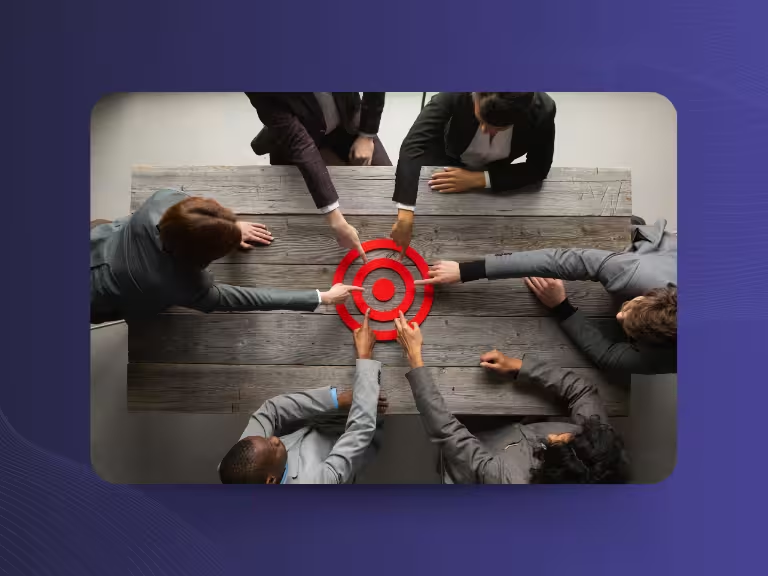Do you know that feeling of thinking after a meeting: "What did we actually accomplish?" You're not alone. Studies show that up to 67% of all meetings are perceived as ineffective – a main reason for this is the lack of or unclear goal setting. Setting goals in meetings is far more than just an organizational formality: it's the key to productive collaboration and measurable results.
In this article, you'll learn how to transform your meetings through proven methods like SMART and OKR, strategic preparation, and intelligent follow-up. We'll show you practical tools, common pitfalls, and psychological aspects that make the difference between time-consuming discussions and efficient work sessions. Whether you lead meetings or want to contribute to better results as a participant – these insights will help you make optimal use of every minute of your meeting time.
The Importance of Clear and Concrete Goals in Meetings
Why Meetings Without Clear Goals Are a Waste of Time
Meetings without defined goals are like ships without a compass – they drift aimlessly. When participants don't know what concrete results are expected, inefficient discussions arise, motivation drops, and valuable working time is wasted. According to a Harvard Business Review study from 2023, teams with clearly defined meeting goals work up to 25% more productively than those without clear goal alignment.
The consequences of unclear goal setting are measurable: discussions go in circles, important decisions are postponed, and participants leave the meeting frustrated and without concrete action steps. This leads not only to direct productivity losses but also to a negative meeting culture that has long-term effects on team dynamics.
Characteristics of Effective Meeting Goals
Effective meeting goals are specific, measurable, achievable, relevant, and time-bound – in short: SMART. But that's just the beginning. What's crucial is that all participants understand and interpret the goals equally. A well-formulated meeting goal answers the questions: What exactly do we want to achieve? By when? Who is responsible?
It's important to distinguish between short-term meeting goals and long-term company objectives. While short-term goals define concrete results of the current meeting, they should always be embedded in the larger strategic context. Frameworks like OKR (Objectives and Key Results) help establish this connection and ensure that every meeting makes a meaningful contribution to the overall strategy.
Proven Methods for Goal Setting in Meetings
SMART Method: Formulating Goals Clearly and Feasibly
The SMART method is a proven framework for precisely defining meeting goals. Specific means concrete instead of vague – instead of "We'll discuss the project," it should be "We'll define the three critical milestones for Q4." Measurable makes success verifiable, attractive ensures motivation, realistic prevents overwhelm, and time-bound creates commitment.
A practical example: Instead of "We'll improve customer satisfaction," a SMART goal reads: "We'll develop three concrete measures by November 15th to increase customer satisfaction in our online shop by 15%, based on current feedback data." This goal is specific, measurable, time-defined, and gives all involved parties a clear direction.

OKR Framework as Strategic Goal Setting
The OKR framework connects Objectives (qualitative goals) with Key Results (quantitative results) and is particularly suitable for strategic meetings. The big advantage: OKRs create a direct connection between short-term meeting goals and long-term company objectives, clarifying the bigger context for every participant.
A practical example: The Objective "Strengthen market position" becomes measurable through Key Results like "Increase market share by 5%" or "Establish three new sales channels." In a meeting, the concrete goal could then be: "We'll define the roadmap for the first new sales channel with concrete implementation steps for the next 60 days."
Preparation and Follow-up – Success Factors for Goal-Oriented Meetings
How Good Preparation Creates Clarity
Preparation significantly determines the success of your meetings. A well-thought-out agenda with clearly formulated goals should be sent to all participants at least 24 hours before the meeting. It's important not only to list topics but also to define desired outcomes and each participant's role.
Effective preparation includes three core elements: goal definition, role distribution, and time planning. Every participant should know what contribution they can make to achieving the meeting goals and what preparation is expected. This not only creates clarity but also significantly increases participation and quality of discussions.
Follow-up to Ensure Goal Achievement
Follow-up is often the neglected part of the meeting process, yet it determines long-term success. Structured documentation of results, clear responsibilities, and defined deadlines are essential. Digital tools like Sally, Trello, or Asana help organize this information and track progress.
Regular follow-ups and feedback mechanisms are particularly valuable. A brief survey or check-in after two weeks shows whether goals are actually being implemented and where adjustments are needed. McKinsey studies prove that digital tools increase the completion rate of meeting goals by an average of 15% because they ensure transparency and traceability.
Practical Tips for Avoiding Common Mistakes and Promoting Acceptance
Common Pitfalls in Goal Setting
The most common mistake in setting goals in meetings is overloading – too many goals lead to overwhelm and lack of focus. Limit yourself to a maximum of three main goals per meeting. Other pitfalls include unclear formulations, lack of prioritization, and neglecting follow-up.
Also make sure to set realistic timeframes. Nothing is more demotivating than unachievable goals or unrealistic time specifications. A good rule of thumb: plan 20% more time than originally estimated and define alternative scenarios in case not all goals can be achieved.
Increasing Participation and Motivation of Participants
Involving all participants in goal definition is crucial for acceptance and engagement. People are more motivated to achieve goals they helped create. Start your meetings with a brief alignment on goals or invite feedback beforehand.
Psychological aspects play an important role: challenging but achievable goals increase intrinsic motivation. Also consider cultural differences in international teams – while some cultures prefer direct goal communication, others appreciate a more indirect approach. Positive group dynamics emerge when all participants feel they can make a valuable contribution.
Digital Tools to Support Goal Setting and Goal Tracking
Modern digital tools are revolutionizing how we set and track meeting goals. Sally, a GDPR-compliant AI meeting assistant, can automatically transcribe meetings, summarize key points, and integrate directly into over 8,000 platforms. Microsoft Teams, Trello, Asana, and Fellow offer similar functions for goal transparency and progress tracking.
These tools help not only with documentation but also with automating recurring tasks. They can send reminders, manage deadlines, and make goal status visible to all involved parties. When selecting tools, you should focus on GDPR compliance, user-friendliness, and integration possibilities. Practical integration works best step by step – start with one tool and gradually expand the system.
.avif)
Summary: How to Set Goals in Meetings Correctly and Efficiently
Clear, well-formulated goals are the foundation of productive meetings. The investment in thoughtful goal setting pays off many times over: through higher productivity, better results, and more motivated teams. Use proven methods like SMART and OKR to formulate your goals concretely and measurably.
Successful meetings begin with careful preparation and don't end with the last word, but with structured follow-up. Actively involve all participants, foster a positive atmosphere, and use digital tools strategically to ensure transparency and traceability.
Remember: Perfect meetings don't happen overnight, but through continuous improvement. Regular feedback and the willingness to adjust processes make the difference between good and excellent meetings. Start today making your next meetings more goal-oriented – your colleagues and your company will thank you.

Test Meeting Transcription now!
We'll help you set everything up - just contact us via the form.
Test NowOr: Arrange a Demo Appointment



